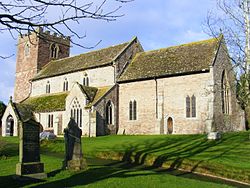Almeley
| Almeley | |
| Herefordshire | |
|---|---|
 St Mary's parish church | |
| Location | |
| Grid reference: | SO334516 |
| Location: | 52°9’28"N, 2°58’36"W |
| Data | |
| Population: | 601 (2011) |
| Post town: | Hereford |
| Postcode: | HR3 6xx |
| Dialling code: | 01544 |
| Local Government | |
| Council: | Herefordshire |
| Parliamentary constituency: |
Hereford |
Almeley is a village in western Herefordshire, about 18 miles north-west of Hereford, 13 miles south-west of Leominster and seven miles from the county's border with Radnorshire.
Just to the north is the hamlet of Wootton and between them a hamlet known as Almeley Wooton (which, with Upcott is bundled in with Almeley's civil parish). The 2011 Census recorded the parish's population as 601.
A walking route through the distinctive, pretty villages of western Herefordshire, the Black and White Village Trail, runs through Almeley.
The village
Much of the present village is built around a triangle of roads, with St Mary's parish church to the south, and on the edge of the built area. East of the church is Almeley Primary School. The village hall is at the eastern point of the triangle. North of the church are The Bells public house and a post office. At one of the road junctions by the church are the war memorial and a small sculpture depicting Almeley Parish.
Of historical interest are the Oldcastle (on the north-west side of the village) and Almeley Castle just south of the church. A brook, offering a reliable water supply, runs past both castles. A third castle is found in the nearby village of Woonton in the parish, near The Mere at a place called ‘Hall Mote’.
Churches
The Church of England parish church is St Mary's. It is largely of the 14-century and is a Grade I listed building.[1]
One of the early Quaker meeting houses is in Almeley Wootton, a hamlet in the parish about half a mile north of Almeley itself. It was given to the Quakers in 1672 by its owner, Roger Prichard, and is still in use by Quakers today. Two of the Quakers who worshipped there (Roger's son, Edward Prichard, and Edward's brother-in-law, John Eckley) were involved with William Penn in setting up the colony of Pennsylvania in 1682.[2]
History

Finds from the parish include Neolithic polished axe heads from Upcott, flint tools from various locations, Roman coins from Spearsmarsh and Eccles Alley, Roman pottery from the Manor House area near the parish church, and coins of King John, King Henry III, King Edward I and most subsequent reigns until modern times, indicating continuous occupation for more than 4,000 years.
The Domesday Book of 1086 records Almeley as a manor.[3] Almeley is also recorded in 14th-century Feet of Fines (property transaction records).[4]
In Samuel Lewis's Topographical Dictionary of England of 1848.[5] the parish is described:
near the road to Hereford; containing 642 inhabitants. It comprises 3,352 acres, of which 1,500 are meadow and pasture, 1,300 arable, and 552 woodland; the surface is undulated and extensively wooded, and the soil, for the most part, is a sandy loam, having a wet sub-soil of marl and clay. A tram railway for the conveyance of coal from Brecon to Kington, passes through the parish. . . . The church is partly Norman, and partly in the English style. About threequarters of a mile north-west of it, was probably once a castle; part of the ditch, &c., being traceable, and the farm there called Old Castle. Sir John Oldcastle, Lord Cobham, executed in 1417 for his attachment to the Lollards, was a native of the parish.—Topographical Dictionary of England, 1848
Sir John Oldcastle, as Lewis notes, was born in Ameley. He was a Lollard or a sympathizer with these early reformers and he was eventually executed for heresy and treason in 1417. Sir John is identified as the original of Shakespeare's character of Falstaff in the two Henry IV plays: the text was apparently changed from ‘Oldcastle’ to ‘Falstaff’ after the first productions to avoid slighting the name of a man seen as a Protestant Martyr, whose descendant, Lord Cobham, was prominent at court.
The whole parish has physical evidence of shrunken settlement at Woonton, Almeley Wootton, Hopleys Green, Upcott and Logaston, numbering more than 100 buildings. There is also map evidence for these lost buildings, which appear to have disappeared by the mid 19th century.
Almeley railway station was opened in 1874 and worked by the Great Western Railway. The GWR closed the station in 1917, reopened it in 1922 and closed it again in 1940. The railway has since been closed and dismantled.
Outside links
| ("Wikimedia Commons" has material about Almeley) |
- Almeley in the Domesday Book
References
- ↑ National Heritage List 1081702: Church of St Mary
- ↑ Almeley Quakers'
- ↑ "Place name: Woonton, Almeley, Herefordshire Folio: 181r Great Domesday Book". The National Archives. http://www.nationalarchives.gov.uk/documentsonline/details-result.asp?Edoc_Id=7577943&queryType=1&resultcount=24210.
- ↑ "Feet of Fines: CP 25/1/83/50". Some Notes on Mediæval English Genealogy. http://www.mediævalgenealogy.org.uk/fines/abstracts/CP_25_1_83_50.shtml. Retrieved 6 February 2015.
- ↑ Lewis, Samuel: 'A Topographical Dictionary of England' (S. Lewis and Co., 1848) p39–44 ISBN 978-0-8063-1508-9 - British History Online
